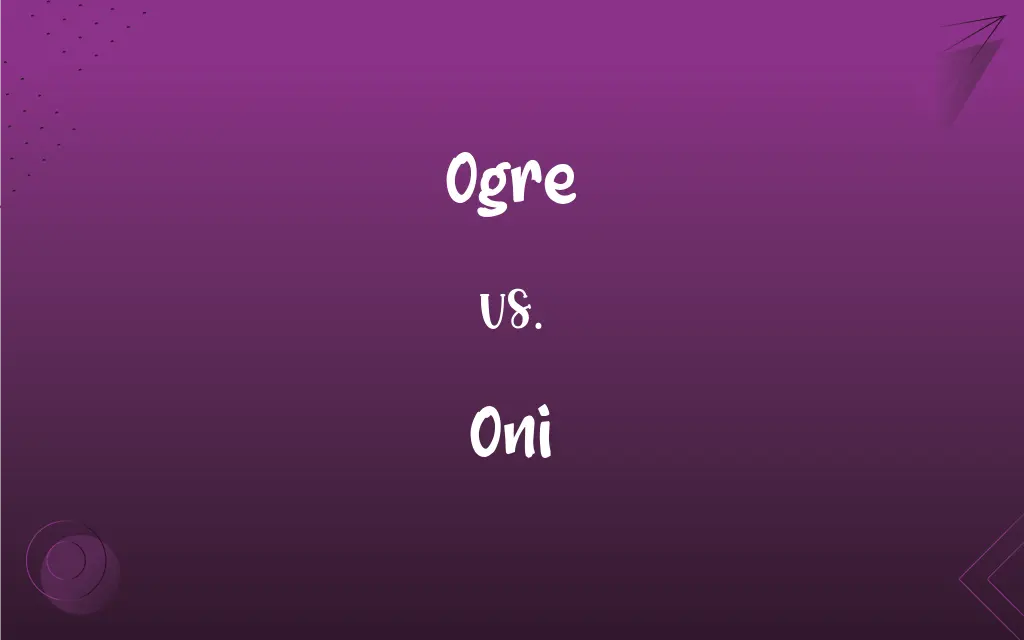Ogre vs. Oni: What's the Difference?
By Janet White & Harlon Moss || Updated on March 4, 2024
Ogres are mythical monsters often depicted as large, hideous, man-like beings that eat humans, primarily in Western folklore. Oni are demons or ogres in Japanese folklore, known for causing disasters, spreading disease, and guarding Hell.

Key Differences
Ogres have their roots in European folklore and literature, typically described as large, fearsome, and solitary creatures with a strong appetite for human flesh. They are often portrayed as stupid and lazy but incredibly strong, living in isolated areas like forests or mountains. Oni, whereas, are significant figures in Japanese mythology and are thought to bring misfortune and are associated with the spirit world. Unlike ogres, Oni are not just brutish but also cunning, and they can have a range of appearances, often depicted with red or blue skin, horns, and carrying clubs.
While ogres are primarily known for their physical prowess and cannibalistic habits, lacking any significant magical abilities, Oni are often attributed with supernatural powers. These powers can include the ability to shape-shift, control natural elements, or cast spells, which they use to challenge heroes or haunt humans. This difference highlights the ogre's role as a physical threat in tales, whereas Oni represent both a physical and spiritual danger.
In many Western stories, ogres are antagonists overcome by cunning or bravery, symbolizing personal or societal fears. They often feature in fairy tales as obstacles for the protagonist, serving as a test of character or bravery. In contrast, stories involving Oni can have deeper spiritual or moral lessons, reflecting aspects of Buddhism and Shinto beliefs in Japan. Oni are not just enemies to be defeated but can also be appeased or converted to protectors, showing a complexity in their roles within folklore.
Ogres, as depicted in tales and folklore, do not usually have a varied hierarchy or types; they are generally uniform in their portrayal as monstrous and greedy. Oni, on the other hand, are diverse in their classification and roles within Japanese mythology. There are many types of Oni, each with unique characteristics, roles, and even rankings within the underworld, indicating a rich tapestry of lore surrounding these creatures.
Ogres in folklore are often solitary creatures, rarely seen in groups and not associated with any particular culture or societal structures. They are outcasts, living on the fringes of human societies. Oni, however, are frequently depicted as part of a collective or society, especially in tales where they inhabit or guard the underworld. This contrast reflects differing cultural views on evil or malevolent forces, with Oni embodying a more organized aspect of spiritual opposition.
ADVERTISEMENT
Comparison Chart
Origin
European folklore
Japanese folklore
Physical Appearance
Large, hideous, man-like
Various, often with horns, wild hair, and different skin colors
Habitat
Isolated areas, e.g., forests, mountains
Underworld, haunted places
Abilities
Physical strength, little to no magic
Supernatural powers, including shape-shifting and spell-casting
Role in Folklore
Cannibalistic monster, physical threat
Cause disasters, spread disease, guard Hell, moral and spiritual threat
ADVERTISEMENT
Societal Structure
Solitary, no specific culture
Often depicted in groups with a hierarchy
Ogre and Oni Definitions
Ogre
A large, frightful monster from folklore that eats humans.
The ogre in the tale lived alone in a castle, preying on unwary travelers.
Oni
Known to cause disasters and spread disease.
A plague was thought to be the work of an Oni, bringing misery to the village.
Ogre
Symbol of fear and brute strength in fairy tales.
Children were warned not to wander into the woods, lest they be captured by an ogre.
Oni
Can be appeased or converted into protectors.
The villagers held a festival to appease the Oni, turning its wrath into protection.
Ogre
Lacks magical abilities, relying on physical prowess.
Despite its strength, the ogre was defeated by the knight's cunning and valor.
Oni
Guardians of the underworld in mythology.
Souls judged unworthy were sent to face the Oni in the afterlife.
Ogre
Often portrayed as dim-witted and easily tricked.
The hero outsmarted the ogre by offering it a mirror instead of his own head.
Oni
Demonic beings in Japanese folklore with supernatural powers.
The Oni used its shape-shifting ability to deceive the samurai.
Ogre
A giant or monster in legends and fairy tales that eats humans.
Oni
Display a wide variety of appearances and abilities.
The blue-skinned Oni wielded a club that could summon storms.
Ogre
A person who is considered particularly cruel, brutish, or ugly.
Oni
A Japanese evil spirit or demon.
Ogre
(mythology) A type of brutish giant from folk tales that eats human flesh.
Oni
The military intelligence agency that provides for the intelligence and counterintelligence and investigative and security requirements of the United States Navy
Ogre
(figuratively) A brutish man reminiscent of the mythical ogre.
Ogre
An imaginary monster, or hideous giant of fairy tales, who lived on human beings; hence, any frightful giant; a cruel monster.
His schoolroom must have resembled an ogre's den.
Ogre
A cruel wicked and inhuman person
Ogre
(folklore) a giant who likes to eat human beings
Ogre
A depiction of isolation and savagery.
The ogre's lair was filled with the bones of its victims, far from any village.
FAQs
How can ogres be identified?
Ogres can typically be identified by their large, hideous appearance and solitary nature.
Can Oni be good?
In some stories, Oni can be appeased or converted, serving as protectors rather than malevolent forces.
Do ogres have any magical abilities?
Typically, ogres do not possess magical abilities and rely on their physical strength.
Are ogres intelligent?
Ogres are often depicted as having limited intelligence, easily outwitted by humans in folklore.
What are ogres known for?
Ogres are known for their great size, strength, and appetite for human flesh, often portrayed as monsters in folklore.
Where do Oni come from?
Oni originate from Japanese folklore, where they are depicted as demonic beings causing misfortune or guarding the underworld.
What is the habitat of an ogre?
Ogres are said to live in isolated areas like forests or mountains, away from human settlements.
What role do Oni play in Japanese culture?
Oni play a significant role in Japanese culture, symbolizing evil forces to be overcome or respected, and are featured in various ceremonies and art.
What powers do Oni possess?
Oni possess various supernatural powers, including shape-shifting, controlling elements, and spell-casting.
What is the significance of Oni in festivals?
Oni are featured in various Japanese festivals, often to ward off evil spirits or misfortune, symbolizing the community's overcoming of bad luck.
What makes ogres distinct from other mythical creatures?
Ogres are distinct for their human-eating habits, great strength, and often simple-minded nature, setting them apart from other mythical beings.
How are Oni depicted in terms of appearance?
Oni are depicted in various ways, often with horns, wild hair, and different skin colors, such as red or blue.
What kind of disasters do Oni cause?
Oni are believed to cause natural disasters, diseases, and other forms of misfortune in folklore.
Do ogres have any cultural significance outside of being monsters?
Ogres serve as symbols of fears to be overcome, representing personal or societal challenges in folklore.
How do Oni reflect Japanese values or beliefs?
Oni reflect aspects of Japanese values and beliefs, including the importance of harmony, respect for the supernatural, and the concept of redemption.
What is the difference between an ogre and a giant?
While both are large and powerful, ogres are specifically known for their monstrous appearance and appetite for humans, unlike giants who may not have these characteristics.
Are Oni always evil?
While traditionally viewed as malevolent, Oni can have complex roles, including acting as protectors when appeased.
Can ogres be part of a community?
Ogres are typically depicted as solitary creatures, not part of any community or society.
How do tales typically depict ogres being defeated?
Ogres are often defeated through bravery, cunning, or trickery by the protagonists of tales.
How are Oni integrated into religious beliefs?
Oni are integrated into Japanese religious beliefs, particularly Buddhism and Shinto, representing moral and spiritual challenges.
About Author
Written by
Janet WhiteJanet White has been an esteemed writer and blogger for Difference Wiki. Holding a Master's degree in Science and Medical Journalism from the prestigious Boston University, she has consistently demonstrated her expertise and passion for her field. When she's not immersed in her work, Janet relishes her time exercising, delving into a good book, and cherishing moments with friends and family.
Co-written by
Harlon MossHarlon is a seasoned quality moderator and accomplished content writer for Difference Wiki. An alumnus of the prestigious University of California, he earned his degree in Computer Science. Leveraging his academic background, Harlon brings a meticulous and informed perspective to his work, ensuring content accuracy and excellence.































































